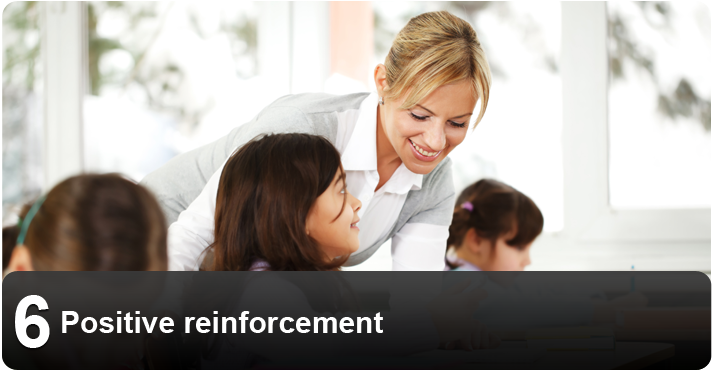|
Table of Contents
|

“The most powerful tool for changing behaviour will come from increasing positive interactions for appropriate behaviour.” – Randall Sprick, Discipline in the Secondary Classroom
Reinforcement is a positive or negative consequence of behaviour. When used effectively, reinforcement makes behaviour more appropriate—negative behaviour is reduced or eliminated, and positive behaviour increases and is maintained. For every correction students receive for doing something wrong, they should receive at least four positive messages about what they are doing right. Positive feelings contribute to an individual’s willingness to change his or her behaviour. Some school staff do this naturally, but others may need to take a systematic approach to increasing their positive reinforcement of students. Formal systems such as monthly recognition awards or positive office referrals are just as much about changing staff behaviour as they are about changing student behaviour. A school-wide approachAn effective school-wide approach to positive behaviour support uses increased opportunities for positive reinforcement to encourage students to behave in positive ways. The biggest factor in the success of a positive reinforcement system is consistency among the adults in the school. The more attention many adults pay to a certain kind of behaviour (whether positive or negative), the more that behaviour is likely to increase. For example, if students are misbehaving and teachers constantly reprimand them, they may actually engage in even more negative behaviour. Noticing and reinforcing students who are behaving safely, responsibly and respectfully increases the frequency of desirable behaviours. To make a reinforcement system effective, implement it across the entire school community and provide all students with access to positive feedback, especially students who have behaviour disabilities. Effective school-wide reinforcement systems:
Positive reinforcement can take many forms. It can be:
To determine whether a consequence is positive, observe whether the desired behaviour is maintained or increases. This is the only way to tell. Something that reinforces the behaviour of one student or group of students may have a neutral or negative effect on others. Always consider the developmental level and personal preferences of the individual student or group of students. Identifying meaningful reinforcementsReinforcement can only be measured in terms of changes in behaviour. If students are not excited or fail to respond to a reward, it is not providing true reinforcement and it is likely time to choose a different one. Varying the reinforcements also increases their value. Many schools hand out “gotcha” slips to students and teachers who are caught demonstrating positive behaviour. Especially during the early stages of implementation, these “gotcha” moments help to create a visible record of the behavioural expectation and provide a model for other students. When the visible effects of positive behaviour become more apparent, these kinds of tangible reinforcements can be phased out. Tangible reinforcement systems are designed to not only change student behaviour but also provide opportunities to influence and change adult behaviour. When they have a certain number of rewards to deliver each day, adults have increased opportunities to (and a context for) increasing their positive interactions with students. They begin providing specific verbal praise for positive behaviour more often. Another kind of reinforcement is an activity or privilege; for example, giving students extra free time or more time for a favourite activity. School-wide privileges might include earning extra minutes of recess. Authentic social praise is an effective natural reinforcer that helps to increase positive behaviour and minimize inappropriate behaviour. For example, adults might nod, smile, laugh, high-five or shake hands; engage in casual conversation; and/or offer assistance. All reinforcers should include clear descriptions of the behaviour being reinforced. For example, “You finished all your work on time.”
|


